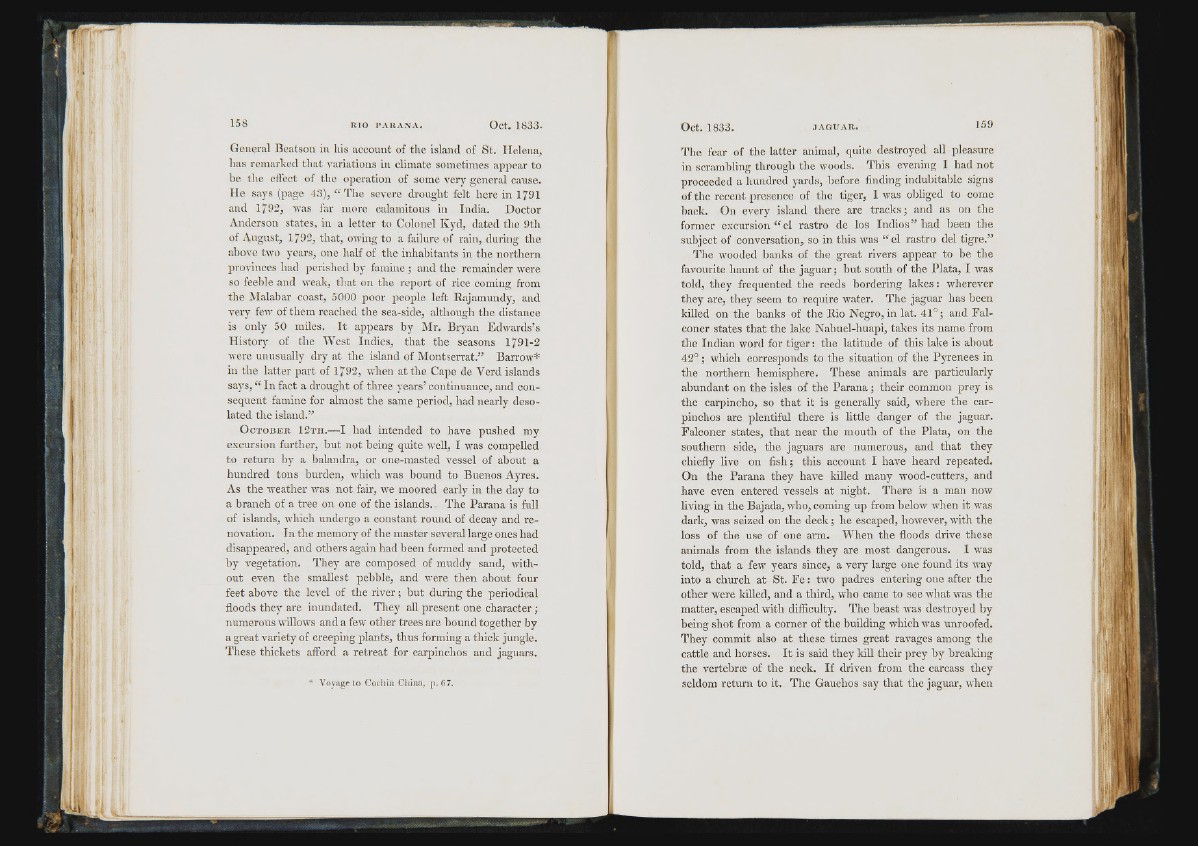
General Beatson in his account of the island of St. Helena,
has remarked that variations in climate sometimes appear to
be the effect of the operation of some very general cause.
He says (page 43), “ The severe drought felt here in 1791
and 1/92, was far more calamitous in India. Doctor
Anderson states, in a letter to Colonel Kyd, dated the 9th
of August, 1 7 9 2 , that, owing to a failure of rain, during the
above two years, one lialf of tlie inhabitants in the northern
provinces had perished by famine ; and the remainder were
so feeble and weak, that on the report of rice coming from
the Malabar coast, 5000 poor people left Rajamundy, and
very few of them reached the sea-side, although the distance
is only 50 miles. It appears by Mr. Bryan Edwards’s
History of the AVest Indies, that the seasons 1791-2
were unusually dry at the island of Montserrat.” Barrow*
in the latter part of 1 /92, when at the Cape de Verd islands
says, “ In fact a drought of three years’ continuance, and consequent
famine for almost the same period, had nearly desolated
the island.”
O c t o b e r 1 2 t h .—I had intended to have pushed my
excursion further, but not being quite well, I was compelled
to return by a balandra, or one-masted vessel of about a
hundred tons burden, which was bound to Buenos Ayres.
As the weather was not fair, we moored early in the day to
a branch of a tree on one of the islands. The Parana is full
of islands, which undergo a constant round of decay and renovation.
In the memory of the master several large ones had
disappeared, and others again had been formed and protected
by vegetation. They are composed of muddy sand, without
even the smallest pebble, and were then about four
feet above the level of the river; but during the periodical
floods they are inundated. They aU present one character ;
numerous willows and a few other trees are bound together by
a great variety of creeping plants, thus forming a thick jungle.
These thickets afford a retreat for carpinchos and jaguars.
Vo y ag e to C o c h in C liin a , p . 67,
The fear of the latter animal, quite destroyed all pleasure
in scrambling through the woods. This evening I had not
proceeded a liundred yards, before finding indubitable signs
of the recent presence of the tiger, I was obliged to come
back. On every island there are tracks; and as on the
former excursion “ cl rastro de los Indios” had been the
subject of conversation, so in this was “ el rastro del tigre.”
The wooded banks of the great rivers appear to be the
favourite haunt of the jaguar; but south of the Plata, I was
told, they frequented the reeds bordering lakes: wherever
they are, they seem to require water. The jaguar has been
killed on the banks of the Rio Negi'o, in lat. 41°; and Falconer
states that the lake Nahuel-huapi, takes its name from
the Indian word for tiger: the latitude of this lake is about
42°; which corresponds to the situation of the Pyrenees in
the northern hemisphere. These animals are particularly
abundant on the isles of the Parana; their common prey is
the carpincho, so that it is generally said, where the carpinchos
are plentiful there is little danger of the jaguar.
Falconer states, that near the mouth of the Plata, on the
southern side, the jaguars are numerous, and that they
chiefly live on fish; this account I have heard repeated.
On the Parana they have killed many wood-cutters, and
have even entered vessels at night. There is a man now
living in the Bajada, who, coming up from below when it was
dark, was seized on the deck; he escaped, however, with the
loss of the use of one arm. AVhen the floods drive these
animals from the islands they are most dangerous. I was
told, that a few years since, a very large one found its way
into a church at St. F e : two padres entering one after the
other were killed, and a third, who came to see what was the
matter, escaped with difficulty. The beast was destroyed by
being shot from a corner of the building which was unroofed.
They commit also at these times great ravages among the
cattle and horses. It is said they kill their prey by breaking
the vertehrte of the neck. If driven from the carcass they
seldom return to it. The Gauchos say that the jaguar, when
ft I